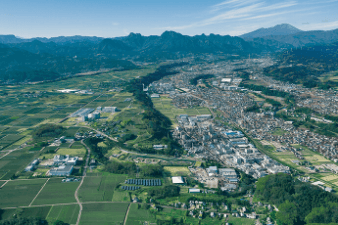Achieving a Sustainable Society
Reduction of environmental impact in plants
: Gunma Complex
Efforts to reduce the environmental impact at Shin-Etsu Chemical Gunma Complex
Shin-Etsu Chemical Gunma Complex is located in Annaka City, which is located in the western part of
Gunma Prefecture and
is surrounded by an environment rich in nature. It is continuously developing as a research and
production base for
state-of-the-art silicon chemistry and plays a role as the main production hub for the products of
Shin-Etsu Silicone.
In 1996, Gunma Complex was the first among major domestic chemical companies to acquire
International Standard ISO 14001
certification concerning the environmental management system. Since then, it has positively
approached sustainability
activities and has steadily obtained good results.
Promotion of Energy Efficiency and Reduction of Greenhouse Gas Emissions
Gunma Complex uses electricity and natural gas with low emissions of greenhouse gases as energy sources Although energy consumption in this Complex rises as the production of silicone products increases, it approaches the promotion of energy savings (reduction of average annual rate of 1% in original units) and the reduction of greenhouse gas emissions (reduction of 45% in comparison with 1990 by 2025 in original units) by introducing a cogeneration system and renewable energy and by implementing measures to save energy in the manufacturing processes.
Examples of Approaches in Gunma Complex
Introduction of Cogeneration System*
Both electric power and steam are generated from the cogeneration system using natural gas as fuel to supply the plants. The electric power is used for motors and lighting, and the steam is used as the heating sources for manufacturing facilities. In addition, power is generated by steam turbines using the pressure difference of steam. The energy utilization efficiency of the system is higher than that of commercial power supply and steam supply from boilers and thus greatly contributes to energy savings and the reduction of greenhouse gas emissions.
* Cogeneration (heat and power supply) system System where electric power is generated by engines, turbines, and fuel cells using natural gas and petroleum as fuel, and the heat generated at that time is collected as steam and warm water simultaneously. Energy consumption efficiency is higher than that of a power company.
Point of Cogeneration
Electric power is supplied from a power company and cogeneration system to the plant in parallel. The system was constructed so that, even if a problem occurred at the power company, the cogeneration system could supply power independently by disconnecting the line to the power company and is useful for emergency measures and continuous production.
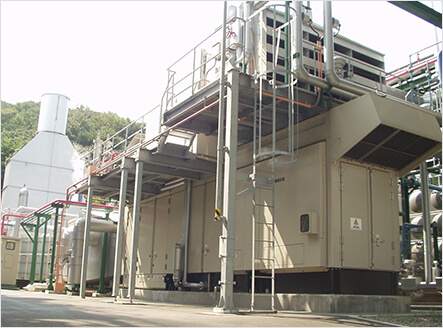
Collection of Waste Heat
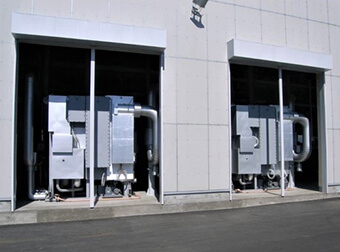
The reactive heat generated in the production processes are collected and effectively used as steam generation and product heating. In addition, part of the steam generated in the cogeneration system produces cold water using absorption type refrigerators, and the cold water is used as the cooling source for the manufacturing facility and the air conditioners in the clean rooms.
Energy Saving Measures in Manufacturing Processes in Each Plant
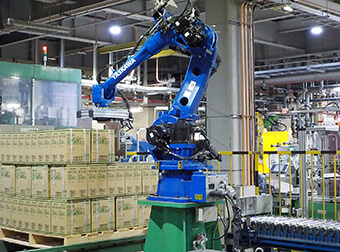
Operation aimed at saving energy is promoted in each manufacturing process.
Introduction of Solar Panels
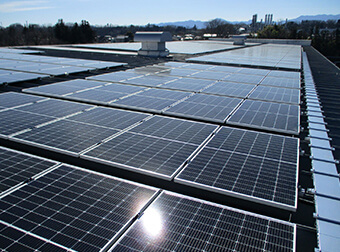
Solar panels with a power generation capacity of approx.148 kW were installed at the Goubara
plant, and operation
started in March 2021. They cover part of the power used at the plant, and the reduction
of CO2 emissions of
approx.72.3 tons per year is expected from annual power generation of approx.160 MWh.*
*Trial calculation from sunlight irradiation in Gunma
Prefecture
TOPICS
Approaches Contributing to Carbon Neutrality
Enhanced by the Silicone Business
By focusing on contribution to carbon neutrality as an important task of
management, our company invests
a total of 20 billion yen in Gunma Complex as the major production hub of the silicone business
to further enhance the
approaches to the reduction of greenhouse gas emissions from both sides through our products and
manufacturing processes.
Please refer to our press release for details.
Approaches to the preservation of water resources by Gunma Complex
Gunma Complex is surrounded by an environment rich in nature and takes in almost all amounts of the water necessary for the production of silicones from peripheral rivers. Since the manufacturing of chemical products requires a large amount of water, this Complex recirculates the water taken in and reutilizes it for production facilities and cooling water as much as possible in order to minimize the amount of water taken in from rivers. In addition, we perform the purification treatment before discharging water to rivers to control the water quality thoroughly.
Examples of Approaches in Gunma Complex
Various facilities for preservation of water resources in Gunma Complex
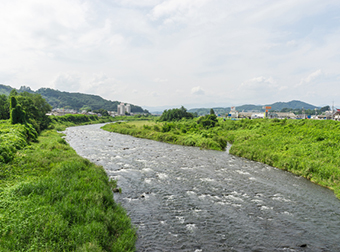
Water intake facility
The Isobe and Matsuida plants take in water from the Yanagise River flowing in the plant and a waterway divided from the Usui River in the vicinity of the plant, respectively, to use it as water sources of industrial water for producing silicones. In addition, city water is also partly used.
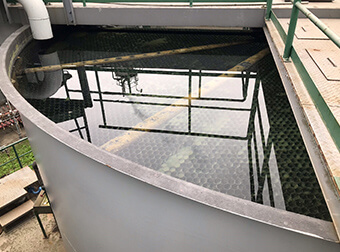
Purification facility for river water
River water taken in is subjected to purification treatment similar to that of waterworks to remove turbidity for use as industrial water to produce silicones.
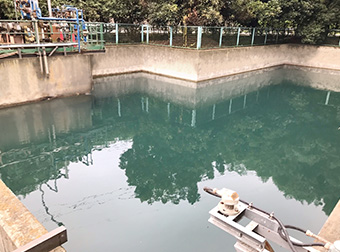
Rainwater pit
Rainwater is stored to be effectively utilized for miscellaneous application.
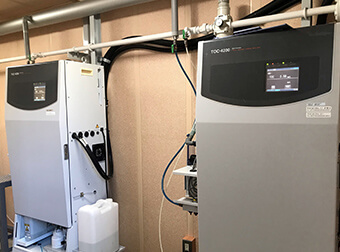
Installation of detectors (TOC (total organic carbon) meter and oil film detector)
A TOC meter is installed at the end of the discharge port of the plant so that when the leakage of chemical substances to drain ditches for rainwater occurs, it can be detected as early as possible. In addition, continuous monitoring is performed using pH meters. Furthermore, oil film detectors are installed at many places in the plant so that when the leakage of silicone fluid occurs, it can also be detected as early as possible.
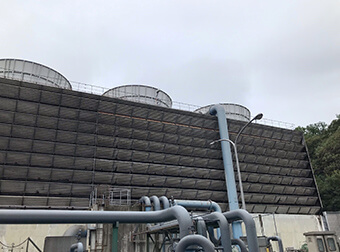
Cooling tower
This is a cooling facility for removing the reaction heat generated during silicone production and the condensing heat generated in the distillation process. Pumps supply water to the production facilities and the water warmed in the cooling process returns to the cooling tower. It is cooled by the tower and supplied again to the production facilities. The tower removes the heat efficiently by using circulating water only by replenishing water that evaporates during heat dissipation.
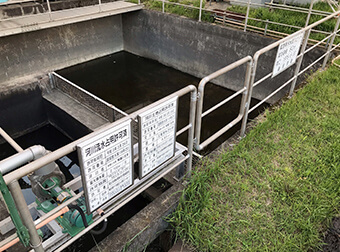
Emergency pit
When the TOC meter or the oil film detector operates and an automatic gate shuts off the water in the rainwater ditch, the drainage is temporarily stored in the emergency pit. The stored water is transferred to a wastewater treatment facility and discharged into the rivers after purification.
Approaches to Reducing Waste Materials and Preventing Air Pollution
Efforts are underway at the Gunma Complex to achieve the Shin-Etsu Group's goal of zero waste emissions (a 1% or less ratio of final landfill disposal volume to waste generation volume). These efforts also include promoting waste generation reduction in terms of emission intensity. Besides, emissions reduction targets have been set to prevent air pollution. Measures to reduce emissions have been implemented, such as switching to fuels with a lower environmental load.
Examples of Approaches in Gunma Complex
Incineration Facility
Industrial waste materials from each plant are collected for incineration and disposal at the incineration facility at the Isobe plant. To reduce dioxin emissions from this incineration facility, the Isobe plant is working on operation management optimization through around-the-clock operation and stable incineration at high temperatures. Its efforts also extend to utilizing the heat generated at the incineration facility to produce steam for each plant.
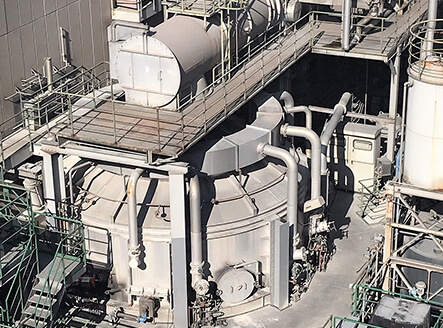
Switching to Natural Gas for Air Pollution Prevention
The Gunma Complex positively uses natural gas as an environment-friendly energy source along with electricity. Natural gas is an ideal energy source: it does not produce much nitrogen oxide (NOx) emissions, which are deemed responsible for acid rain and air pollution, and produces no sulfur oxide (SOx) emissions (see the figure above). Accordingly, the Gunma Complex stays well below the emission standard for NOx, and its SOx emissions remain below the measurable lower limit.
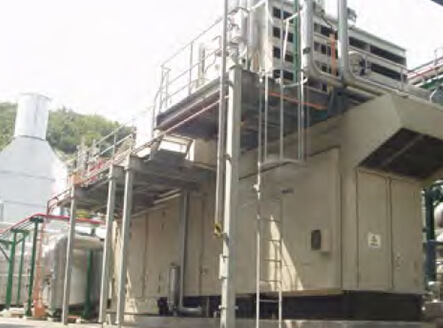
TOPIC
Cleaning activities for roads
around the office
Every year, the Gunma Complex cleans the roads around the plant as part of its environmental
beautification campaign. We
spend about two hours each time collecting empty cans, PET bottles, and paper scraps that have
been thrown away along
the road. In addition to contributing to the local community, this activity is also useful for
raising employees'
environmental awareness and enlightening their manners.
Achieving a Sustainable Society
Solving social issues through the products
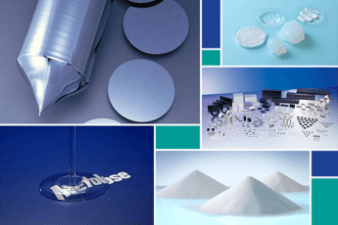
With the environment
Silicone Polyvinyl chloride resin (PVC) Rare Earth MagnetComfortable living
Polyvinyl chloride resin (PVC) Caustic soda Silicon wafers / Magnet Silicone Electrophysiological Dry Electrodes / High-Stretchable Wiring Material Cellulose derivativesReduction of environmental impact in plants
